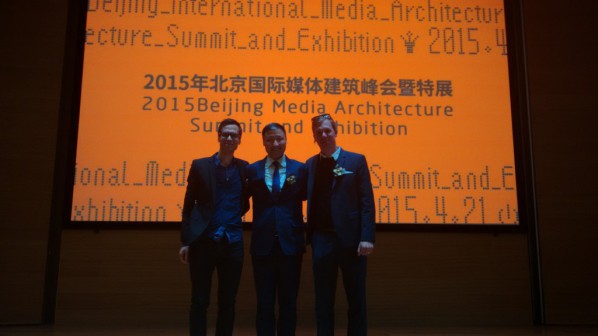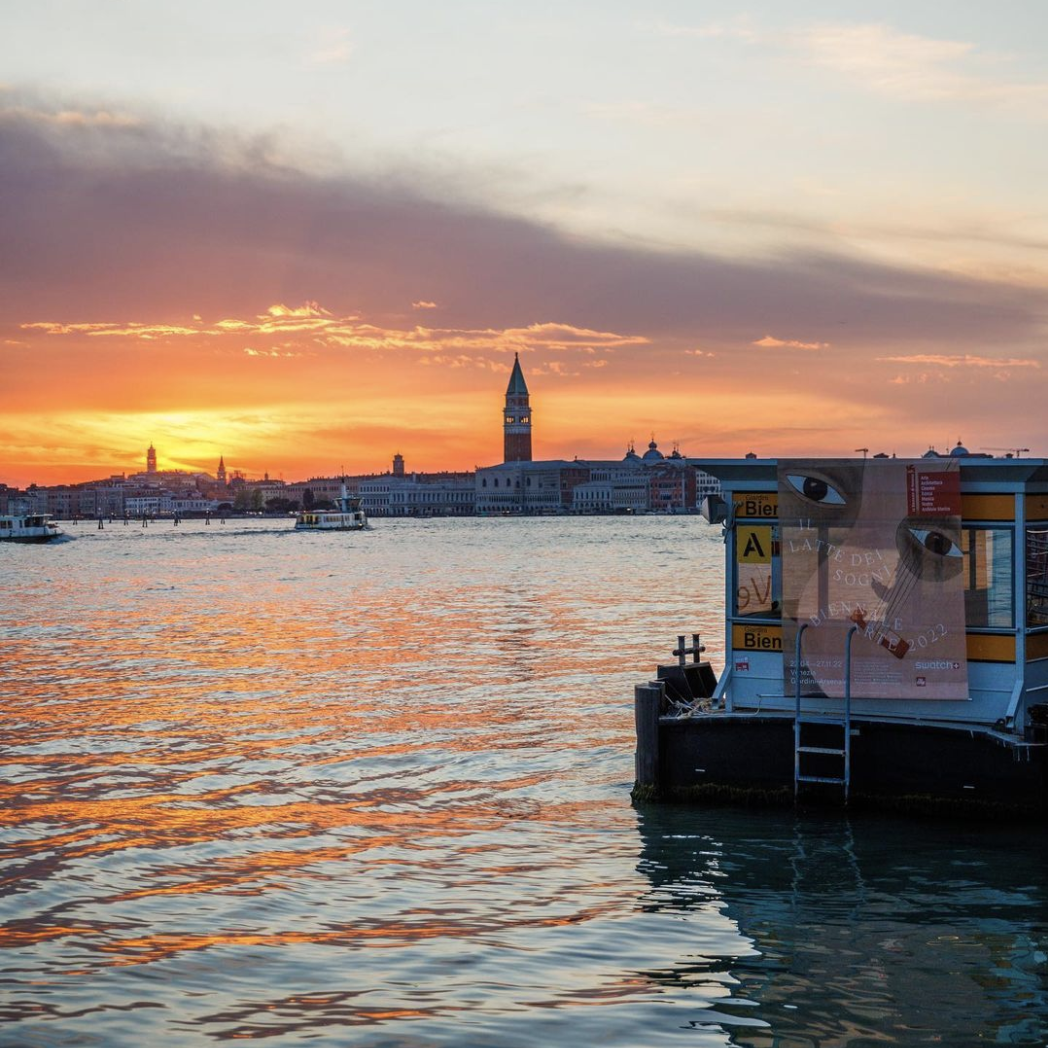
The Media Architecture Institute announces that they have opened a MAI branch in China. The new MAI China office is situated at China’s Central Academy of Fine Arts, one of most competitive art schools in China and a longtime partner of the institute. The local MAI China director is Professor Chang Zhigang, Vice Dean of the architecture department at CAFA. The new MAI branch was formally established during the Beijing Media Architecture Summit and exhibition 2015, held during the 15th and the 16th of April at CAFA museum. Through the new branch in China MAI is directly positioned in the largest and fastest growing country of media architecture and it allows the institute to research deeper into the issues of media architecture, smart cities and digital place making. All three MAI offices in Vienna, Sydney and Beijing are working now together on further exhibitions, prototype installations, book publications and organising events around the globe such as the upcoming Media Architecture Summit America 2015 in Boston, Media Architecture Summit Europe 2016 in Frankfurt and the Media Architecture Biennale 2016 in Sydney. Prof. Chang is welcome to join in the MAI team and all its members look forward to the future collaborations in researching media architecture topics in China.
About the Media Architecture Institute
The Media Architecture Institute is a non-profit organisation designed to complement the work of established universities and research institutions with a flexible but very focused research activity linking industry, education and academia together.
Founded in fall 2009 by Dr Gernot Tscherteu, Dr Oliver Schürer, DI Wolfgang Leeb and Dr Martin Tomitsch, the Institute continues the work of the Media Architecture Group that co-organised the Media Architecture Conference London 2007 and the Media Facades Festival Berlin 2008 – in particular the conference and the exhibition.
In 2010 the Media Architecture Institute organised the Media Facades Summit 2010 in Frankfurt and the Media Architecture Biennale 2010 in Vienna.
In 2011 the Media Architecture Institute was expanded from its European base in Vienna to a second office in Sydney where Dr M. Hank Haeusler and Dr Martin Tomitsch are responsible for the Australasian region. Vienna remained responsible for the European / American region with Ben Stricker and Tobias Ebsen joining the Institute in 2012.
In April 2012 the Media Architecture Institute organised the 2nd Media Facades Summit 2012 in Frankfurt as part of the Light and Building Exhibition hosted at the St?delschule. In November 2012 the Institute together with Aarhus University’s CAVI organised the Media Architecture Biennale 2012 in Aarhus.
These events where followed by the Media Facades Summit 2013 in Hong Kong, the Media Facades Summit 2014 in Frankfurt and again in Aarhus the Media Architecture Biennale 2014. In 2015 the institute opened a third office in Beijing with Prof. Chang Zhigang responsible as director for the MAI China branch. MAI China was officially announced at the Media Architecture Summit 2015 in Beijing.
The current Institute members are:
Professor Chang Zhigang PhD, Architecture school of Tsinghua University, Beijing. Teaching and research in lighting design and architecture design. Professor and vice dean of Architecture school, China Central Academy of Fine Arts, Beijing. Member of China Green Building and Energy Saving Committee; Member of editorial committee of China Architecture Education; Member of editorial committee of China Illuminating Engineering Journal; Member of editorial committee of Professional Lighting Design – Chinese Version; Member of Chinese Artists Association; Member of the council of China Illuminating Engineering Society; Project evaluation expert of The National Natural Science Foundation of China.
Dr Martin Brynskov, associate professor in interaction technologies and director of Digital Design Lab at Aarhus University, Denmark, general chair of the Media Architecture Biennale 2012 and 2014. He has lead large-scale urban interaction design projects with artists and cities since 2007 as part of Center for Advanced Visualization and Interaction (CAVI), Digital Urban Living (DUL) and the Participatory IT Centre (PIT). Martin has a Ph.D. from the Center for Interactive Spaces, Computer Science, Aarhus University, an M.A. in Information Studies, and also holds a degree in Classical Greek.
Dr Tobias Ebsen, researcher, designer and artist working with media art installations. Since 2008 he has produced and co-produced a number of installations and experimental prototypes that explore the potentials of digital technology in public space. He is currently a PhD candidate at Aarhus University and works at the Center for Advanced Visualization and Interaction (CAVI).
Dr M. Hank Haeusler, senior lecturer in the School of Architecture at the University of New South Wales, Sydney, Australia. Haeusler is known as a researcher, educator, entrepreneur and designer in media architecture, digital technology, interaction design and ubiquitous computing and author of four books, several book chapters and conference papers.
DI Wolfgang Leeb, architect and architectural photographer, working with Gernot Tscherteu since 2002. As a trained architect with construction experience he is responsible for the techinical parts. Research on mediafacades, concepts for facade solutions and exhibition design are his focuses within the MAI collective.
Ben Stricker M.A., worked as an independent event designer mostly for clubs and consumer events in Germany. Since 2008 he worked on technical innovations in the field of media architecture and developed an innovative LED lamp for which he received an award from Zumtobel Lighting GmbH. Stricker worked on media facade projects in Europe and Australia always combining practice with research.
Dr Martin Tomitsch, lecturer and interaction design researcher at the Design Lab, an interdisciplinary group within the Faculty of Architecture, Design and Planning at the University of Sydney. His work was shown at several exhibitions including Vivid Sydney. He is the author of two books and over 30 research articles.
Dr Gernot Tscherteu, interaction designer and researcher at realitylab.at. With a background in political science, Tscherteu has worked for the Austrian Academy of Science, University of Applied Arts, ZKM Karlsruhe, and the Vienna Museumsquarter. Tscherteu has curated numerous events in the field of media facades and media architecture.
Dr Alexander Wiethoff, lecturer and researcher at the University of Munich (LMU). His experience includes long term professional consulting activities combined with various educational and research activities on media architecture. His professional industrial experience in the areas of interaction design has been gained as an employee and consultant, which has included work for various fortune 500 clients. Alexander holds a a Ph.D. in Computer Science from the University of Munich (Ger), an M.A. in Interaction Design from the Interaction Design Institute Ivrea, Milan (I) and a B.A. in space&designstrategies from the University of Art and Industrial Design, Linz (A).
Staff
Juan C. Carvajal B., studied architecture at the National University of Colombia and the Technical University of Vienna. Since 2006 he began to explore the relation between architecture, digital media and urban space. He participated in 2009 in the Ars Electronica festival in Linz with the installation called Loom. With the project cicloscopio he won a Jury-award in the Velo-city cicling visionary awards 2013. He has been selected as finalist for the Paseo project (Zaragoza) competitions of 2012 and 2013. [more]
Petra Hendrich, studied architecture at the Technical University of Vienna and sociology at the University of Vienna. She is also a trained mediator. Her master thesis focused on cohousing projects in Vienna. Since 2010 she works for realitylab, where she collaboratively works with people in the field of housing and urban development. Her focus lies on the development and moderation of social structures within groups of residents, that want to develop a co-housing project together. She also helps to implement organisational structures within existing communities. Since 2010 she also supports the MAI on an organisational level. Moreover she contributes her knowledge of social processes and design to MAI research projects.
Courtesy of the Media Architecture Institute, for further information please visit www.mediaarchitecture.org.




























